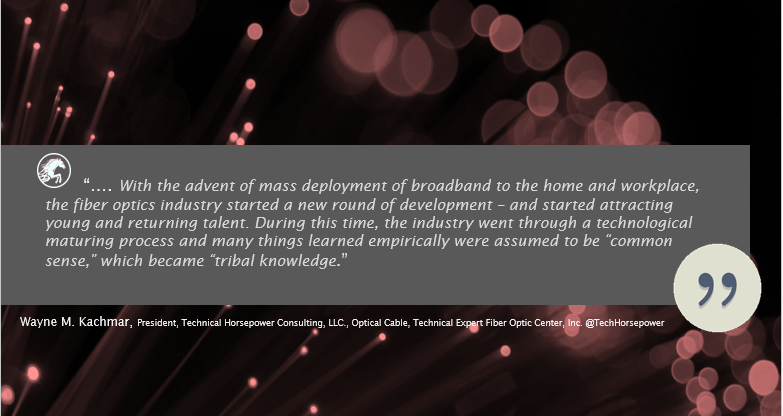Are we doomed to repeat the past? Not letting our industry’s critical "tribal knowledge" become lost.
As more colleagues from my generation move toward retirement, I am concerned that the collected knowledge we gained empirically is not fully being preserved for the next generation of fiber optic engineering professionals.
Why do I say the collected knowledge gained is not preserved for the next generation of fiber optic engineering professionals?
If you look at the demographics, there is a missing generation of fiber optic engineers or at least a dearth of them. If you’re old enough to remember, the 2001-2003 period in our industry suffered a significant recession. Prior to this, there was a build-up of expectations about what fiber would do and expected demand for bandwidth.
Many companies had spin-offs to exploit new fiber optic ventures – in some cases, with nothing more than a patent application. While bandwidth demand increased so did copper’s capabilities. Fiber solutions (expensive at the time) were put on hold. Since everyone assumed the same volume but disputed how much market share they would take, huge overcapacity existed, and expensive new technologies did not realize their cost targets.
That generation of fiber optic engineers started to be laid off in large numbers, many with only a few years experience in the industry. As a result, many new technologies came into widespread development: areas such as electro-mechanical interfaces, remote vision systems, laser-based manufacturing, and so forth.

Young engineers moved out of the optical fiber and cable industry
Needing a solid industry to base their future careers on, many young engineers moved out of the optical fiber/cable industry to these newer, more promising areas. Since most of these areas offered excellent opportunities, these engineers did not return to the optical fiber industry. Plus, engineering schools deemphasized fiber optics as a major development area.
By the time the industry started to recover, many companies decided to work toward standard products and processes. While this was good in helping the industry mature, it did not offer the best opportunities for young engineers to concentrate their careers on.
Fiber optics industry new round of development
With the advent of mass deployment of broadband to the home and workplace, the fiber optics industry started a new round of development. It started attracting young and returning talent. During this time, the industry went through a technological maturing process and many things learned empirically were assumed to be "common sense," which became "tribal knowledge." Don’t misunderstand me here, big things were learned and reported, and they found their way into texts, process design books, and technical papers.
However, some of the smaller things – such as design for existing installation methods, pre-bend insensitive fiber design, and red flag tests seem to be a lost art. By way of example, I have noticed that methods of pulling cables, especially small interoffice cables, miss the concept of using a capstan-type device.
Another item to note is that, as new manufacturers enter the market, making a cable (especially an indoor cable) clearly strippable is becoming another lost art.
Are we likely to repeat fiber optic cable design faults?
Does this mean we are likely to repeat some (or most) of the design faults that plagued early fiber optic cable designs? I hope not. Several of the groups that teach installers how to handle fiber optic cable are acting as conduits between generations of installers.
But I wonder if we need a similar type of "conduit" for cable designers, especially before all of us who started in this industry when it was "rocket science" fade away into retirement.



